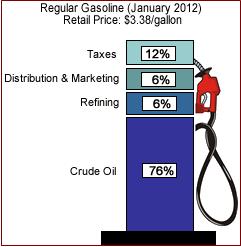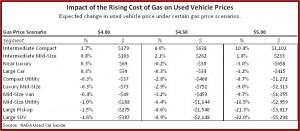
“If military action is taken against Iran, then all bets on how high gasoline prices will go are off."
Gasoline prices in the U.S. continue to rise at $3.80 a gallon, with the average diesel fuel price now above $4 per gallon, according to the U.S. Energy Information Administration. EIA estimates that the world oil market has become increasingly tight over the first two months of this year. Oil prices have risen since the beginning of the year and are currently at a high level but below the $4.11 recorded in July 2008,
What this means for the recovering U.S. vehicle market is unclear. New vehicle sales have been slowly rising but are still far below pre-Great Recession rates. What is clear is that this is bad news for drivers and energy consumers because liquid fuel consumption is at historically high levels globally.
While the economic outlook, especially in Europe, remains uncertain, continued growth is expected. Unusually cold weather in Europe contributed to tighter markets by increasing the demand for heating oil, particularly during February.

Less fuel efficient vehicles could get whacked in the used car market with a severe drop in trade-in values.
On the all-important supply side, there have been ongoing supply interruptions this year, including production drops in South Sudan, Syria, Yemen, and the North Sea. Both the United States and the European Union (EU) have also acted to tighten sanctions against Iran, of course, including measures with both immediate and future effective dates.
These measures may already be causing some adjustments in oil supply patterns even though the take effect in the future. As and example, EIA says that some shipments of Iranian crude oil under existing contracts are being curtailed due to the unwillingness of U.S. and EU insurance providers to cover them, even though the EU sanctions only require existing oil contracts to be completely phased out by July 2012.
“Considering consumers have become accustomed to gasoline prices that averaged more than $3.50 last year, this time around we don’t expect to see dramatic shifts in the shopping behavior of consumers for more fuel-efficient vehicles when prices approach the $4 mark,” Banks said.
“Looking at opposite ends of the fuel-economy spectrum, prices for used compact cars, like the Ford Focus or Honda Civic, at $4 per gallon will increase by an average of $179,” He estimates prices for large SUVs, such as the Chevy Tahoe, will decline by $387, while price adjustments for other vehicle segments will land somewhere in between.
Banks added that gasoline prices would have to move further into unknown territory for used-vehicle prices to change more dramatically. At $4.50 per gallon, compact car prices would increase by $638 or 3.5 times the rate of growth at $4, while prices for large SUVs would fall by $2,148 or 5.5 times the loss at NADA’s forecasted gasoline price peak.
“If military action is taken against Iran, then all bets on how high gasoline prices will go are off,” he said.

